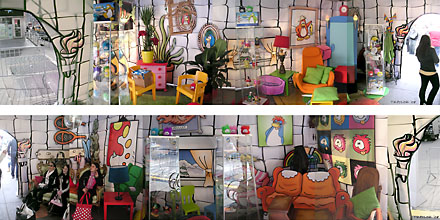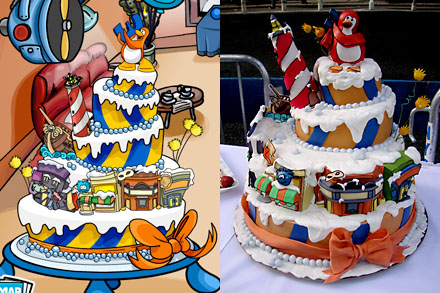Tuesday, October 28th, 2008
Club Penguin celebrates its third anniversary! To mark the event, Disney and Club Penguin held a big anniversary party this past Friday in the heart of New York City. Excited fans and their parents could be found waddling around the festivities inside the midtown Manhattan Toys R Us and also across the street in the middle of Times Square.

Montage photo of Times Square event. (Click image to see larger photo.)
There were many things to do and see, as well as announcements to hear. The outdoor celebrations included personalities from Radio Disney and the Disney Channel. Entertainment included guest star appearances, many dance numbers on stage, and even a visit from Club Penguin co-founder, Lane Merrifield who thanked everyone for making Club Penguin such a huge success. The event was simulcast online through the Club Penguin website and also projected on the ABC Jumbotron! Nearby, a custom decorated tent, doubling as an igloo, looked like it jumped right off the webpages of the Club Penguin website. Tasty treats were on hand for all

A look inside the igloo. (Click image to see larger photo.)
the little ones and an amazing 3rd anniversary cake was made in honor of the celebration!
Across the street, inside the Toys R Us store, many additional surprises awaited which includeda number of new Club Penguin books (I think I saw four different books), plush penguins (I’m going to guess about 12

Online and offline anniversary cake. (Click image to see larger photo.)
different characters), and many new Club Penguin toys. Computers were set up for kids to try their hand at Club Penguin for the first time and additional tables were nearby so visitors could play the latest games now available including a Club Penguin branded Mancala and a card game called Fast Flippers. Users could even test out the soon to be released Club Penguin Nintendo DS title called Elite Penguin Force. The official Club Penguin blog also announced a series of Club Penguin trading cards that will be available sometime this coming November.
So, what’s noteworthy here? Well, aside from the party, a number of things. After watching the Club Penguin business for more than a couple of years, I am impressed with how Disney has proceeded after the acquisition of Club Penguin. I had a fear that the sweetness and innocence of the Club Penguin site would be lost through this acquisition and would soon become a site cluttered with advertisements. I am thrilled to report that the Club Penguin site is even better today than it was before the Disney acquisition. The only visible change is a separate webpage with information on where Club Penguin toys can be purchased. This is, however, located outside the Club Penguin world.
Also, the folks at Disney and Club Penguin have spent a lot of time trying to determine how best to grow this virtual world beyond the sizable user base they already have. First, you can see the Club Penguin website has just become international, with the inclusion of Portuguese as a language option in addition to English. Not an easy undertaking considering the live monitors needed to watch the site’s activity very closely. I’m betting you’re going to see more languages added here soon. Second, instead of the typical revenue approach offered through monthly subscriptions often used with other virtual worlds for kids, Club Penguin is extending revenue support through physical product that include numerous ties back to the website. The new products announced at the anniversary celebration include special physical “coins” attached to the plush penguin dolls and codes woven into games and books that unlock unique Club Penguin rewards. For example, within the Club Penguin world, an activity can ask for the special word found on page 46 paragraph 2 word 14 of one of the new books, and once this word is entered into the activity, prizes await. Also, it’s been stated that coins collected in the new Nintendo DS game can be transferred into a child’s online account too. Pretty cool! Now the cynic in me might say this is too much consumerism, but I have to acknowledge the amazing commitment to quality and careful thought put into these new products. A child does not have to be a paid subscriber of the site in order to take advantage of these rewards.
The solitary subscription model and in-world advertising approach to grow a children’s virtual world is looking like an outdated thing of the past. Club Penguin and Disney are positioned to capitalize on it’s consumer product strength to grow Club Penguin numbers like no other virtual world offering for kids can. Waddle on Club Penguin! Waddle on!
Video of the Club Penguin anniversary event in NYC’s Time Square.


 When I first became aware of Peggy Charren, I had been creating children’s media for only a short time. What I learned in those days was that Peggy founded a child advocacy group in 1968 called
When I first became aware of Peggy Charren, I had been creating children’s media for only a short time. What I learned in those days was that Peggy founded a child advocacy group in 1968 called  This past week I was at Northwestern University to participate in a conference called
This past week I was at Northwestern University to participate in a conference called